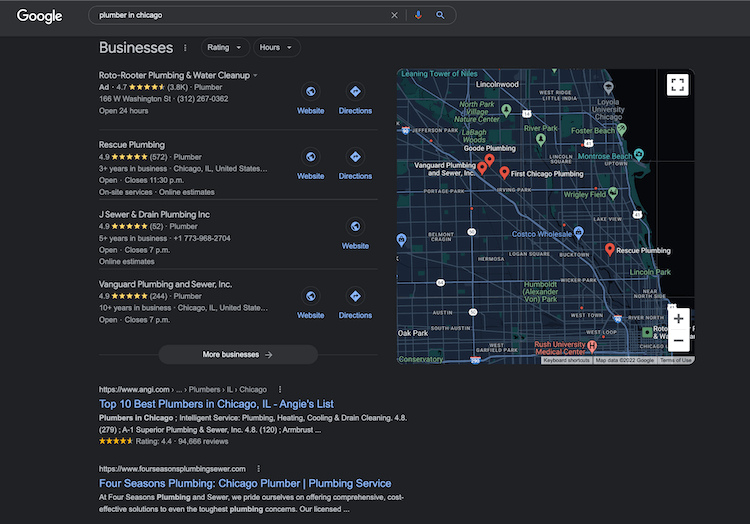Google Rankings and SEO

Google Rankings and SEO – What You Need To Know Before Creating a New Website
If you’re like most people embarking on the creation of a new website, you probably have heard about SEO. Maybe you know that you are supposed to work on the SEO of the new site, but you’re not quite sure what that entails, or where to start, or why it would be worth the extra energy and/or cost.
We’re here to explain what SEO is and why it’s important. We’ll also provide some easy tips that can help get your new site ranking on Google.
First things first, what IS SEO, anyway?
SEO, or search engine optimization, is the process of optimizing a website to increase the quantity and quality of the traffic that comes to the site through search engines. To do this, it’s important to optimize your website so that the search engine (most often Google) knows how to read and interpret your site. That way, when people look for your product or service, Google knows to include your site in the search results. At the same time, it’s crucial to consider the people who you want to visit your site: what they are looking for, how they use search engines, and what kind of experience they would want when they land on your site.
SERPS
A lot of SEO can be distilled into one metric: rankings in search engine results pages (or SERPs, for short). If you’re a plumber then you want people to be able to find your website when they search for a plumber in your area. If your website doesn’t appear on the first page of the Google search results, then they probably won’t call you. It’s that simple. We use the example of a plumber, but there are so many businesses that rely on searches in Google to make people aware of their business – from real estate agencies, to investment firms, to car dealerships, and much more.
In this way, SEO might sound like a large, daunting challenge. But if you take it in small chunks, and learn a few basics, then you’ll be well on your way.

Why bother at all?
SEO might seem like extra work to a lot of folks, but consider what happens if you don’t put any effort into bringing high quality traffic to your site. In that case, it’s likely that very few people will see your website at all. SEO is a simple and basic process of connecting interested internet users with your website, so that you can have the greatest reach possible.
Basic Steps for SEO Beginners
-
-
Know Your Market
The first step in any SEO process is to understand the market for your product or service. Having developed your business plan, you are probably aware of the market to a certain extent – you probably have a sense of the competition and have an idea of what will differentiate your business to make it successful. But, do you know your search competition? Do you know how Google treats searches for your product or service? Do you know how hard it will be to rank for your product or service?
It’s true: search competition is often different from direct market competition. Search competition refers to other websites that will compete for a page-one slot on Google’s SERPs. And the type of search competition that you get depends on how Google treats your industry. Is your product/service treated as a local search, or a national one? Is it a competitive search ecology, or a relatively untapped one? All of these questions will be crucial to understanding the steps you should take to optimize your site, and also will give you a sense of what you can expect when you launch. For instance, if you have a business that is treated as a local service, then you will need to make sure to create a Google My Business page. But this would be largely unnecessary if your business is not locally-oriented and operates solely for a national or international audience.
-
Know Your Audience
In the same way that you need to get to know your market from a search perspective, you also need to get to know your audience from a search perspective. It’s not just who your audience is, it’s also how your audience looks for (and finds) the service or product they are looking for. What specific terms do they use? What phrases do they type into Google? What lingo, what location terms, what technical terms? Or do they not use Google at all and instead find these products on social media, or through other websites. SEO can address that, too.
This is the step where technical SEO assistance can be of use. SEO specialists have dedicated tools that look “under the hood” of Google to see what people actually search for and how they land on a site. If you’d like to start doing the research yourself, there are some limited tools you can use to get a pretty good picture of the landscape. Google trends and Google Keyword Planner (part of Adwords) are both free tools that offer limited research options. Other tools like SEMRush, Wordtracker, Majestic and MOZ are more powerful tools that give more detailed and granular data, but which have subscription fees. However, most of them offer free trials if you’d like to try them.
We recommend that whatever tools or methods you use, you make a list of 10 to 25 keyword phrases to focus on. For small sites, ten phrases will do. For larger sites, 20 or 25 will be good. The more content you have on your site, the more phrases you can support. This list of keyword phrases will be your bible – you’ll use them as much as possible.
Quick tip: Remember that you need to be discerning about which phrases you use. You can’t just “win” on a keyword phrase – you have to actually have content that engages with this keyword phrase and you need the content to be part of your real sales pitch. In other words, if you want to use a keyword phrase, then you need to make sure that a person using that keyword phrase will find what they are looking for when they arrive at your site.
-
-
-
Organize Your Site
SEO isn’t just something you add to your site just before launch. SEO is something that should actually inform your website’s organization. Ideally, your keywords should be a guide to your site architecture, helping you decide what pages you want to develop and how they frame your sales pitch. If you are a plumber and you decide that being able to respond to plumbing emergencies is one of the ways you want to differentiate yourself, then you will probably have choose “emergency plumber” as a keyword phrase, and you will want to likewise create a page on the site that responds to this keyword query. Where this page will go, and what pages it will be related to, is dependent on the other phrases you’d like to use.
-
-
-
Feed the Spiders
Spiders are a nickname we use for the software that Google uses to “index” websites on the web. These spiders “crawl” the world wide web, creating indexes of the websites that Google then uses to deliver search results. It’s important that you make your website “spider friendly” so that when Google’s software gets to your site, you give them as much relevant data as possible.
Making a website spider-friendly is pretty easy, but you have to engage with a little bit of technical, development-side website stuff. First, be sure to tell the spiders when your site is ready to be crawled (or recrawled). You do this by making sure you don’t have “no-index” tags on your site, and also submitting your URL to Google search console for crawling.
Next, be sure to tell the spiders about your images. Spiders can’t see the images, they can only read about them. So each image should have an relevant “alt” tag with a brief description of the image. It helps if you can use keyword here. Keep them brief – the spiders will only read about 75 characters.
Finally, be sure to add title and description meta tags to each page on your site. These are tags that tell both the spiders and the users of your site what they will find on each page.
-
-
USE your keyword phrases
Finally, a good SEO strategy includes using the actual keyword phrases on pages AND creating new content regularly that uses the keywords. In your on-page content (the actual text that appears on your web pages), work the keyword phrases in a few times. Try to use them occasionally in a heading for bonus points. Don’t stuff the keyword phases into your content, as it will make the experience of reading your site less enjoyable for visitors. The keywords should be useful enough that you can simply put a little bit of effort into rephrasing something, or adding a heading, and you’ll have 2 to 4 instances of the phrase on a page.
SEO Is Easier Than You Think
There you have it. Five quick steps you can take to make your website more easily found on the web, and more useful for your audience. It’s easier than you think!
At Millennial we take pride in the high quality websites we design and develop. If you need help with your web project – including SEO help – get in touch. We’ll be happy to walk you through our process and answer any questions you might have.





